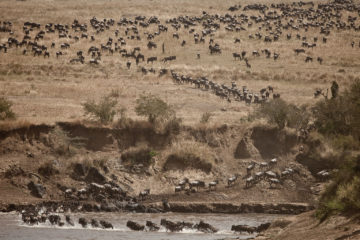Liz Kimbrough in Mongabay:
 When it comes to climate solutions, your first thought may not be the wildebeest. But in the Serengeti, these buffalo-looking antelopes are the key to carbon capture.
When it comes to climate solutions, your first thought may not be the wildebeest. But in the Serengeti, these buffalo-looking antelopes are the key to carbon capture.
Wildebeest eat large amounts of grass and recycle it back into the soil as dung. So when their population plummeted in the early 1900s due to a disease transmitted from domestic cattle, the loss of natural grazing led to more frequent and intense wildfires, turning the Serengeti into a carbon source.
Efforts to bring back or “rewild” the wildebeest population through disease management were a huge success, helping reduce the frequency and intensity of wildfires, and restoring the Serengeti back into a carbon sink.
Trophic rewilding, or restoring and protecting the functional roles of animals in ecosystems, is an overlooked climate change solution, says a new report published this week in the journal Nature Climate Change.
More here.
